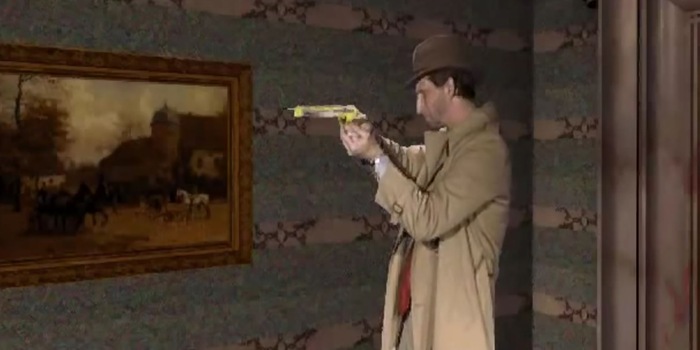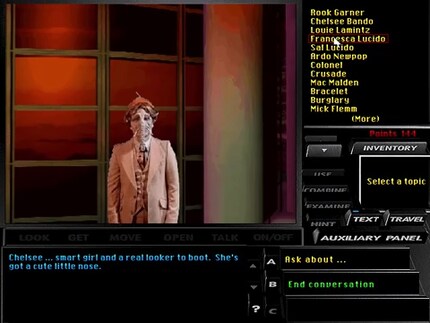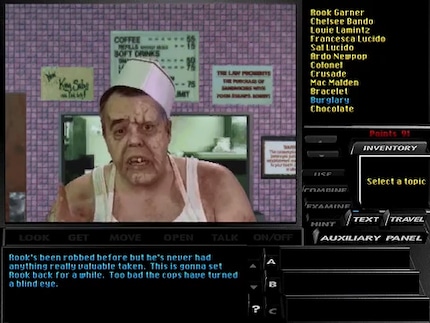
Do you remember? "Under a Killing Moon"
Tex Murphy, private detective. Recently divorced, bare, with a drinking problem. The clumsy main character of the "Tex Murphy" series was not exactly a role model. Nevertheless, as an eleven-year-old in 1994, I practically idolised the game.
Murphy lives in San Francisco in the year 2042, where society has been profoundly changed by World War III. Okay, not that profoundly. As is typical for science fiction works, the game reflects the grievances of our society - not that I would have noticed this as an eleven-year-old. Instead of a class society with no noticeable physical differences, there are two types of people in the year 2042: the Norms and the mutants.
As was common in the 90s - Chernobyl and the Cold War were even better remembered than they are today - the population's greatest fear was a nuclear war. The game plays on the fear of the consequences. The bodies of the mutants have changed in various ways due to the radioactivity. The Norms still have bodies like ours because they are immune to radioactivity.


Unlike mutants in other games, they don't crave your brain matter in "Under a Killing Moon". They try to build their own, peace-loving identity alongside the Norms. This makes them extremely endearing. There's the chocoholic Clint, who lives in a rubbish bin. He only has one eye due to the radioactivity. Beek Nariz is more obviously recognisable as a mutant. His nose resembles the trunk of an elephant.
What it's all about
Tex Murphy lives among them. With his trench coat and fedora, he looks straight out of a film noir. The Humphrey Boagart character typically has more luck than sense in the adventure genre. This and his dry humour with his sometimes crude remarks make him extremely likeable. Incidentally, Murphy is played by Chris Jones, designer and director of the game. This resulted from Jones' hobby of making short films. For budget reasons, other people involved in the project have taken on smaller roles. Hollywood celebrities such as Brian Keith, Margot Kidder and Russel Means also took part. And last but not least - this was widely advertised on the packaging: James Earl Jones.
And you get to hear him right at the beginning. After Darth Vader and Simba's father, James Earl Jones finally achieves god status. This is what he speaks. With an ironic undertone, he explains to his assistant that Tex Murphy is not the best person to save the world.
After another short sequence, you learn that the Nazis are still active in 2042 - in the form of a cult. Then you finally reach Murphy. He has hit rock bottom. His wife has left him, his detective agency is not running at all and he is in danger of losing it too.
In order to get some money, Murphy goes door-to-door. Luckily, the pawnshop was robbed last night. Murphy has a case and can finally earn some money. The game is divided into chapters, each lasting one day. Each day is announced with a Word Art-like animation. Today it looks terrible at what feels like eight frames per second, for me it was the highest of feelings to see the screen. A new chapter at last, what's next?
After the introductory chapter, Tex is tasked by Countess Renier with recovering a stolen statue. From here, Murphy becomes entangled in the Nazi cult's plot to ethnically cleanse the world. As you can see, the story is extremely absurd. Nevertheless, the classic detective story captivated me from the very beginning.
How does it play
The game is a hybrid of interactive film and real-time 3D. It fits in with the times. The big full-motion video boom was coming to an end and the real-time 3D revolution was just beginning. I was thrilled by the mix back then. And it still warms my heart today when I watch sequences. Although I do get a bit scared of eye cancer.
You control Murphy with the keyboard and mouse from a first-person perspective. However, the controls are definitely not up to date. To look around, you actually have to press up to seven buttons, which then allow you to look in different directions. Simply tedious.
The puzzles are also very confusing at times. Fortunately, you earn in-game points through interactions. You can exchange these for tips. Due to a bug, I basically received an infinite number of points. If I open a certain barrel over and over again, the game mistakenly rewards me with points for the action every time. Actually, you only get them once. How I celebrated that - my first contact with cheating.
Thanks to this system, I found out that I could scare a bad guy by attaching a clown doll to a crane or disabling a laser system with a toy crossbow.
But the game also offers plenty of other nice details. There's Murphy's incredibly cool car, which looks a bit like a DeLorean on steroids. Incidentally, the licence plate reads "PVT - DICK", a nice allusion that I only noticed now as an adult. The game is also a great period piece. Murphy receives the order from Countess Renier by fax. That's right, you heard correctly. In the year 2042, as the developers imagined it in 1994, faxing is still used. Just great from today's perspective.
Must-play
An interactive film made by an amateur filmmaker who also plays the main character alongside other amateur actors and ageing Hollywood stars. Can that work? In the case of "Under a Killing Moon", it definitely did. It's not the presentation, the story or the puzzles that make "Under a Killing Moon" still playable today, but the endearing characters. First and foremost Chris Jones alias Tex Murphy. Not that Jones plays particularly well, he definitely doesn't. But that's exactly what makes the character so charming. Somehow you can take Tex Murphy from Jones. I still do, even after all these years. And the fact that the game feels like a mix of "Blade Runner", "Twin Peaks" and "Fallout" still makes it a must-play today. <p
From big data to big brother, Cyborgs to Sci-Fi. All aspects of technology and society fascinate me.
Interesting facts about products, behind-the-scenes looks at manufacturers and deep-dives on interesting people.
Show all